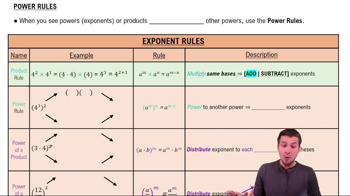State the derivative rule for the logarithmic function f(x)=log(subscript b)x. How does it differ from the derivative formula for ln x?
Table of contents
- 0. Functions7h 54m
- Introduction to Functions16m
- Piecewise Functions10m
- Properties of Functions9m
- Common Functions1h 8m
- Transformations5m
- Combining Functions27m
- Exponent rules32m
- Exponential Functions28m
- Logarithmic Functions24m
- Properties of Logarithms36m
- Exponential & Logarithmic Equations35m
- Introduction to Trigonometric Functions38m
- Graphs of Trigonometric Functions44m
- Trigonometric Identities47m
- Inverse Trigonometric Functions48m
- 1. Limits and Continuity2h 2m
- 2. Intro to Derivatives1h 33m
- 3. Techniques of Differentiation3h 18m
- 4. Applications of Derivatives2h 38m
- 5. Graphical Applications of Derivatives6h 2m
- 6. Derivatives of Inverse, Exponential, & Logarithmic Functions2h 37m
- 7. Antiderivatives & Indefinite Integrals1h 26m
- 8. Definite Integrals4h 44m
- 9. Graphical Applications of Integrals2h 27m
- 10. Physics Applications of Integrals 3h 16m
- 11. Integrals of Inverse, Exponential, & Logarithmic Functions2h 31m
- 12. Techniques of Integration7h 41m
- 13. Intro to Differential Equations2h 55m
- 14. Sequences & Series5h 36m
- 15. Power Series2h 19m
- 16. Parametric Equations & Polar Coordinates7h 58m
3. Techniques of Differentiation
Basic Rules of Differentiation
Problem 3.3
Textbook Question
Find the derivatives of the functions in Exercises 1–42.
𝔂 = x³ - 3 (x² + π²)
 Verified step by step guidance
Verified step by step guidance1
Identify the function to differentiate: 𝔂 = x³ - 3(x² + π²).
Apply the power rule to differentiate x³. The power rule states that the derivative of x^n is n*x^(n-1).
Differentiate the term -3(x² + π²). Use the constant multiple rule, which allows you to take the constant outside the derivative, and then apply the power rule to x².
Recognize that π² is a constant, and the derivative of a constant is zero.
Combine the derivatives of each term to find the derivative of the entire function.
 Verified video answer for a similar problem:
Verified video answer for a similar problem:This video solution was recommended by our tutors as helpful for the problem above
Video duration:
2mPlay a video:
Was this helpful?
Key Concepts
Here are the essential concepts you must grasp in order to answer the question correctly.
Derivative
The derivative of a function measures how the function's output value changes as its input value changes. It is defined as the limit of the average rate of change of the function over an interval as the interval approaches zero. In calculus, the derivative is often denoted as f'(x) or dy/dx, and it provides critical information about the function's behavior, such as its slope and points of tangency.
Recommended video:

Derivatives
Power Rule
The power rule is a fundamental technique for finding derivatives of polynomial functions. It states that if f(x) = x^n, where n is a real number, then the derivative f'(x) is given by n*x^(n-1). This rule simplifies the differentiation process, allowing for quick calculations of derivatives for terms involving powers of x.
Recommended video:
Guided course

Power Rules
Constant Rule
The constant rule in differentiation states that the derivative of a constant is zero. This means that if a function includes a constant term, it does not affect the slope of the function at any point. For example, in the function y = x³ - 3(x² + π²), the term -3π² is a constant, and its derivative contributes nothing to the overall derivative of the function.
Recommended video:

The Power Rule

 3:59m
3:59mWatch next
Master Derivatives of Linear Functions with a bite sized video explanation from Patrick
Start learningRelated Videos
Related Practice
Textbook Question
